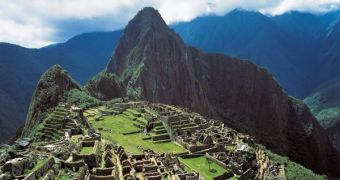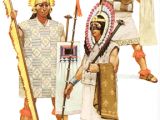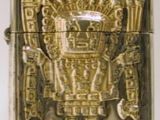In 1527, starting from Panama, a handful of Spaniards led by Francisco Pizarro managed to conquer the largest empire a pre-Columbian civilization ever created. The empire of Incas stretched through the highlands of Andes, in today's Ecuador, Peru, south Columbia, western Bolivia and northwest Argentina and it numbered 10 million people. The name of Inca came from the appellative of the emperors; the name of the people was Quechua and they still make most of the indigenous population of Ecuador, Peru and Bolivia (in this last country, together with Aymara).
The Inca Empire comprised the most abrupt part of the Andes chain, in whose valleys and fractions an array of original cultures (Moche, Nazca, Chimu, Tiwanaku) had developed previously, civilizations whose many achievements were inherited and perfected by the Incas. The colossal Inca architecture was outstanding, with its cities having paved and regular streets, sewage systems, roads, palaces, temples, but also the fortresses, agricultural terraces, irrigation ditches, and so on. One of the most famous Inca fortresses is Macchu Picchu, on the top of the Andes at 4,000 m (13,300 ft) altitude, which could have been at the same time an astronomic observatory and religious center. The stone carving and the cut of the enormous stone blocks were made without using iron tools! Moreover, the Incas did not know the wheel.
It was said that the Inca Empire was somehow socialist, or even communist. There was almost no private property, all the land was communal, not of the individuals; all labored the fields equally and the products were divided between the members of the village in equal proportions. All the people wore exactly the same clothing, and adornments were used only during certain festivities. The houses were uniform, small, made of adobe, clean and pleasant, but with not too much comfort. All the people ate the same items and in the same amounts.
But this equality was applied only amongst the people of the same rank. Over the humble classes of farmers, there were the chiefs of the villages, subordinated to the chiefs of the tribes. Upper on the hierarchy the local governors were found, and, above them, the supreme master of all, the Inca. The Incas belonged to a sole tribe whose members made an aristocratic class dominating the most important offices of the empire (governors, great priests, military chiefs).
The tribe of the proper Inca originated in the Lake Titicaca area, in the ancient kingdom of Tiwanaku, who worshiped the sun. The supreme Inca god was Inti (the Sun), followed by Illapa (the Thunder), and Quilla (Mother Moon), but they also worshiped an omnipotent god, creator of the Universe, and preserver of the order of the stars, called Viracocha. The Andean condor was the totem animal for the Inca, being called Son of the Sun. The puma too was a totem animal.
The cult of these gods was directed by priests who learned their duties in special schools. The high priest was always a relative of the Inca, an uncle or brother of him. The temples had large fields and llama herds, whose products were destined to the necessities of the cult. These included llama sacrifices, ritual libations and orations; their religion was by no mean so cruel like that of other pre-Columbian societies, such as Aztecs, Mayas or even neighboring Araucans; and only during great calamities, to appease the gods, human sacrifices were practiced. Next to the temples, there was a type of convent where acllacunas, virgins of the Sun lived, who dedicated their lives to the service of the gods.
The Quechua Indians are rather short, with massive bodies, short legs, large arms, quite dark skin, wide skulls, large and aquiline noses, almond-shaped eyes, pronounced cheekbones, and straight black hair. Their physiology was and is adapted to the high altitudes where they live, as they make agriculture at 4,000 m (13,300 ft), or keep herds of llamas, alpacas and vicunas.
Low class Inca women practiced agriculture together with their husbands. Men caved the Earth with a coarse shovel, while the women followed removing the stones and breaking the clods. Women and men sowed, weeded out and harvested. Women also ground the corn, prepared the food, wove to cotton and wool, made clothes and ceramics.
Women were married above their will; when reaching the marriage age, they were submitted to a kind of examination by the authorities of the village: the most beautiful were sent to the convents of the Virgins of the Sun, others to the harems of the nobles and the Inca, and the rest were handed over as wives, with a strict order, to the young men who had reached the age for matrimony; together with the wife, the man received a land plot and a house (but all these belonged, as said, to the village). The entire crop was handed over to the chief of the village, which stored it in communal deposits, from which the products were distributed to everybody.
Low class people also had to make some free services, like working the lands of the nobles (who did not engaged in farming), of the temples, or to take care of the huge llama herds of the Inca, but also to enter the army when necessary. In the Andean Altiplano, the Incas cultivated the corn, potato, cinchona, peanuts; in lower lands, people also cultivated bean, sweet pea, squash, cassava, tomato, chili pepper, avocado, guava and others, and, in the warm areas, cotton, coca and maguey were cultivated. The Incas also cultivated tobacco, which was not smoked, but chewed. Coastal populations fished, using boats made of fascicles of reed.
In the areas being too high or too arid for agriculture, the base of the economy was represented by the husbandry of the South American camels: llama, alpaca, and vicuna (the last animal was wild). The herds grazing the pastures near the villages were communal property. The llama is extremely resistant to the high altitude, it can stand days without drinking or eating and it can carry loads with a secure step on mountains paths that horses (introduced later by Spaniards) could not pass. Still, the animal is famous for its stubbornness and cannot carry too large loads and for too long, that's why the llama caravans also comprised spare animals.
Still, in the Inca Empire, the transport of goods, building stones and trades was made on the back of the animals. Llama, alpaca and vicuna were also used for getting wool. Wool was processed in craft workshops. The extremely fine wool of alpaca and vicuna, resembling silk, was destined exclusively to the temples and Inca. Extremely beautiful fabrics were made of this wool, for making mantles. Incas also adorned themselves with feathers or jewels made of gold, silver and gemstones.
The Incas loved music; they had drums of various types, bronze gongs, copper bells, rattles, bone flutes, trumpets, burned clay-made whistles and panpipes made of reed. Their musical scale was in 5 tones, and they composed hymns, love songs and epic poems. In the Inca court, located in Cuzco, dances and mimes were celebrated, including a beginning of dramatic art.
The power of the Inca Empire resided in its perfect military organization. The structure of the society and the hierarchy allowed a rapid raise of troops. All men received military instruction and when asked to, they joined the army, making bodies of regular armies, at precise locations. Military campaigns were carefully prepared and a developed network of spies checked the weak points of the enemy. A network of powerful fortresses allowed the defense of the empire. There were provision stores for the marching armies, united through a magnificent network of roads, daily crossed by a good system of relief runners, which transmitted news from one point to the other of the empire. Still, the Inca weaponry was quite simple: slings, bows and arrows, spears, javelins, maces, axes. The soldiers were protected by shields, wooden helmets and cotton vests. No match for even a handful of conquistadors.

 14 DAY TRIAL //
14 DAY TRIAL // 

